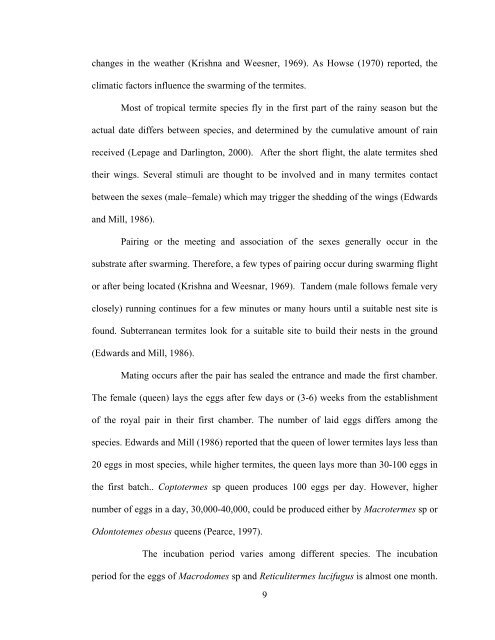SALAH SALEM OBAID GURBEL - ePrints@USM
SALAH SALEM OBAID GURBEL - ePrints@USM
SALAH SALEM OBAID GURBEL - ePrints@USM
Create successful ePaper yourself
Turn your PDF publications into a flip-book with our unique Google optimized e-Paper software.
changes in the weather (Krishna and Weesner, 1969). As Howse (1970) reported, the<br />
climatic factors influence the swarming of the termites.<br />
Most of tropical termite species fly in the first part of the rainy season but the<br />
actual date differs between species, and determined by the cumulative amount of rain<br />
received (Lepage and Darlington, 2000). After the short flight, the alate termites shed<br />
their wings. Several stimuli are thought to be involved and in many termites contact<br />
between the sexes (male–female) which may trigger the shedding of the wings (Edwards<br />
and Mill, 1986).<br />
Pairing or the meeting and association of the sexes generally occur in the<br />
substrate after swarming. Therefore, a few types of pairing occur during swarming flight<br />
or after being located (Krishna and Weesnar, 1969). Tandem (male follows female very<br />
closely) running continues for a few minutes or many hours until a suitable nest site is<br />
found. Subterranean termites look for a suitable site to build their nests in the ground<br />
(Edwards and Mill, 1986).<br />
Mating occurs after the pair has sealed the entrance and made the first chamber.<br />
The female (queen) lays the eggs after few days or (3-6) weeks from the establishment<br />
of the royal pair in their first chamber. The number of laid eggs differs among the<br />
species. Edwards and Mill (1986) reported that the queen of lower termites lays less than<br />
20 eggs in most species, while higher termites, the queen lays more than 30-100 eggs in<br />
the first batch.. Coptotermes sp queen produces 100 eggs per day. However, higher<br />
number of eggs in a day, 30,000-40,000, could be produced either by Macrotermes sp or<br />
Odontotemes obesus queens (Pearce, 1997).<br />
The incubation period varies among different species. The incubation<br />
period for the eggs of Macrodomes sp and Reticulitermes lucifugus is almost one month.<br />
9







![[Consumer Behaviour] - ePrints@USM](https://img.yumpu.com/21924816/1/184x260/consumer-behaviour-eprintsusm.jpg?quality=85)








